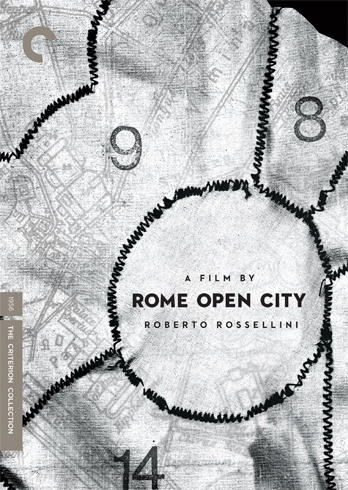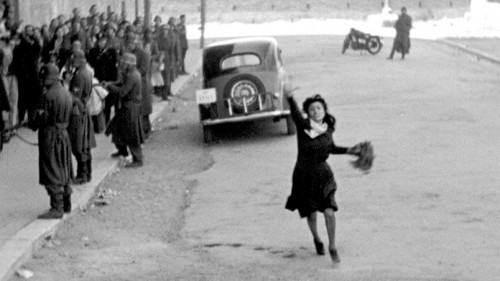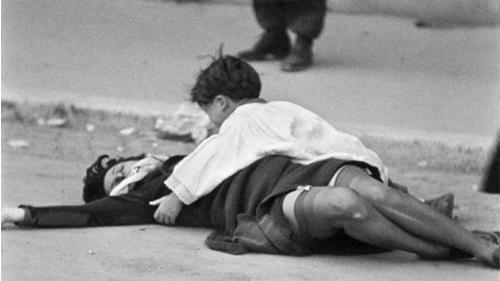
Rome, Open City:
Directed by: Roberto Rossellini
Written by: Federico Fellini, Sergio Amidei
Starring: Aldo Fabrizi, Anna Magnani, Marcello Pagliero
Cinematography by: Ubaldo Arata
Music by: Renzo Rossellini
Released: September 27th, 1945
 Neorealist cinema has featured into the Criterion Files before– I wrote about Vittorio De Sica’s classic entry in the movement, Bicycle Thieves, much earlier this year (and followed that piece up with an examination of Matteo Garrone’s Gomorrah, arguably a contemporary neorealist effort despite valid arguments that neorealist cinema no longer exists)– but Rossellini’s landmark contribution to neorealism, Rome, Open City, represents a very different side of that Italian-born aesthetic. For all of its somber qualities, Bicycle Thieves comes to be characterized by alternating airs of tragedy and hope; it is a film that recognizes the immense struggles of people gasping for breath in post-war Italy but which underscores its bleaker observations with a quiet, powerful sense of human optimism.
Neorealist cinema has featured into the Criterion Files before– I wrote about Vittorio De Sica’s classic entry in the movement, Bicycle Thieves, much earlier this year (and followed that piece up with an examination of Matteo Garrone’s Gomorrah, arguably a contemporary neorealist effort despite valid arguments that neorealist cinema no longer exists)– but Rossellini’s landmark contribution to neorealism, Rome, Open City, represents a very different side of that Italian-born aesthetic. For all of its somber qualities, Bicycle Thieves comes to be characterized by alternating airs of tragedy and hope; it is a film that recognizes the immense struggles of people gasping for breath in post-war Italy but which underscores its bleaker observations with a quiet, powerful sense of human optimism.
Rome, Open City, on the other hand, is rife with discontent and unrest, and never once suggests the potential for its characters to find succor in post-war Italy. In point of fact, the film feels downright angry, but then, Italian neorealism isn’t typically described as being joyfully escapist and unabashedly happy. Notes of resentment, of contempt, of national pride ring throughout Rome, Open City; in any culture in any part of the world, Rossellini’s masterpiece may to this day be the most important post-war film of all time, a picture that perfectly encapsulates the emotional and mental states of a country following the traumatic wounds inflicted by foreign occupation and international warfare. Behind the camera, it’s more than apparent that Rossellini’s thoughts can be summed up in a single two-word phrase: “I tedeschi.”
Amazingly, Rome, Open City isn’t at all defined by xenophobia or cultural hatred, no small feat when every single non-Italian character that appears in the film happens to be a loyal Nazi. An Austrian man defects and attempts to flee with the aid of Don Pietro (Aldo Fabrizi) and Giorgio (Marcello Pagliero); a German officer, his courage bolstered by several generous helpings of whiskey, defies his commander, proclaiming that Italians possess true courage while simultaneously lamenting that Germans are only good at killing. If the former character feels real, the latter feels like a medium through which Rossellini speaks to us, and may even be considered some form of wish fulfillment. “If only the Germans truly were this self-aware,” he seems to be saying while also blatantly celebrating and championing the bravery of his fellow Italians.
At the same time, Rossellini strives to capture the fear of the Italian characters with a contrasting sense of precision. In fact, he once directly described Rome, Open City as a movie about the fear Italians felt during the war and during the occupation. Maybe it should go without saying that an invaded and impoverished citizenry should be afraid of their oppressors, but Rome, Open City goes beyond merely making the statement and shows us their anxiety and dread in stark clarity. A group of elderly women gird themselves for a surprise inspection early in the film, and no matter how hard they try they cannot fully mask their distress at the intrusion. Rossellini clearly shares their consternation and discomfort.

It’s hard to blame him for his numerous sentiments, of course. Nor is it impossible to accept the concept of the remorseful German in light of the fact that not every German soldier and citizen believed in the cause of the Third Reich. But then again, Rome, Open City isn’t about fashioning an even-handed portrait of life in Italy during Germany’s extended invasion. As an Italian, Rossellini’s bias and intentions are both clear: he wants to capture the suffering his countrymen endured throughout World War II and decry his country’s former allies, condemning their ideologies and their brutality. If his cast includes a sympathetic figure within the ranks of the German army, it’s only to underscore the cruelty and arrogance of his fellow Gestapo officers. The end result is that Rome, Open City is as unsparing of the German forces as it is compassionate toward the Italian resistance.
It may be worth noting that Allied forces don’t figure into Rossellini’s narrative whatsoever. There are obvious reasons for this; after Italy signed an armistice with the Allies in September of 1943 (the act that prompted Germany to consolidate their power and take over their former ally’s country), it took roughly ten months for Allied forces to wrest control of the city away from Axis defenders. In that span of time, it was largely Italian patriots who fought for their country and struggled against Gestapo suppression, and Rossellini’s intention is to memorialize the efforts of his fellow Italians to defy the Germans rather than lionize the Allies. To that end, his film barely even mentions them in passing, and never depicts them on screen for one moment. Rome, Open City is about Italians fighting for Italy; heroes belonging to other nationalities need not apply.
But there are speculative reasons for their lack of presence here, too. When the Allies wrested control of Rome from the Axis, the determination was made that anything created by the fascist Axis forces needed to be dismantled immediately; this ultimately led to the shutdown of Cinecittà, the heart of Italian cinema, which in turn brought about the stagnation of the entire Italian film industry. With no money available for funding pictures, Italy’s movie scene became a wasteland, and it’s from that lifeless field that Rossellini’s film sprang, but it’s hard not to wonder if he bore any resentment toward his city’s liberators for hamstringing his livelihood as they did.
The dissolution of Cinecittà, of course, raises an essential question in any study of Rome, Open City: where did Rossellini manage to acquire financial backing? How did it end up getting made? It’s uncertain, much as most of the events surrounding the production remain mysteries to this day; we don’t know whether Amidei or Fellini had more input in the screenwriting process, and we don’t know if Rossellini really received the money necessary to make the film from a wealthy elderly patron, or if he just sold all of his possessions to keep the project alive.

What we do know is that the events of the film have a foundation in reality, that Rossellini, Amidei, and Fellini all suffered through World War 2 in their own ways, and that Rome, Open City reflects reality in a way that escapist cinema simply cannot. While Rossellini’s film isn’t technically the first of its kind– scholars generally apply that title to Luchino Visconti’s Ossessione– it is the neorealist film that pushed the aesthetic onto a global stage and helped inspire a new, vibrant, but brief period of Italian filmmaking.
